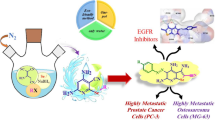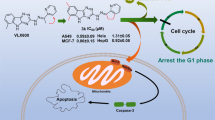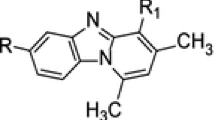Abstract
Fifteen rhenium(I) tricarbonyl complexes of the form fac-[Re(N,O’)(CO)3(X)], where N,O’-bidentate ligand = 2-picolinic acid (Pico); 3,5-difluoropyridine-2-carboxylic acid (Dfpc); 3-trifluoromethyl-pyridine-2-carboxylic acid (Tfpc) and X = H2O; pyrazole (Pz); pyridine (Py); imidazole (Im); and methanol (CH3OH) were synthesized using the ‘2 + 1’ mixed ligand approach with an average yield of 84%. The complexes were characterized using the following spectroscopic techniques: IR, 1H and 13C NMR, UV/Vis, and single-crystal X-ray diffraction. The effect of the fluorine atoms on the backbone of the N,O’-bidentate ligand was investigated and a trend was noticed in the carbonyl stretching frequencies: with Pico < Tfpc < Dfpc. The in vitro biological screening on Vero (healthy mammalian), HeLa (cervical carcinoma) and A549 (lung cancer) cells revealed one toxic complex, fac-[Re(Pico)(CO)3(H2O)], with respective LC50 values of 9.0 ± 0.9, 15.8 ± 4.9 (SI = 0.570) and 20.9 ± 0.8 (SI = 0.430) μg/mL. As a result, it can be used as a positive control drug of toxicity.





Similar content being viewed by others
Data availability statement
The in vitro biological datasets generated during and/or analysed during this study are available from the corresponding author on reasonable request.
References
DeVita VT Jr, Rosenberg SA (2012) Two hundred years of cancer research. New Eng J Med 366:2207–2214
Di Lonardo A, Nasi S, Pulciani S (2015) Cancer: we should not forget the past. J Can 6:29–39
Hajdu SI (2011) A note from history: landmarks in history of cancer, part 1. Cancer 117:1097–1102
Mitrus I, Bryndza E, Sochanik A, Szala S (2012) Evolving models of tumor origin and progression. Tumour Biol J. Int. Soc. Onco. Biol. & Med. 33:911–917
Dasari S, Tchounwou PB (2014) Cisplatin in cancer therapy: molecular mechanisms of action. Eur J Pharm 740:364–378
Mcquitty RJ (2014) Metal-based drugs. Sci Prog 97:1–19
Ip M, Lui SL, Poon VKM, Lung I, Burd A (2006) Antimicrobial activities of silver dressings: an in vitro comparison. J Med Micro 55:59–63
Thomas S, McCubbin P (2003) A comparison of the antimicrobial effects of four silver-containing dressings on three organisms. J Wound Care 12:101–107
Guo Z, Sadler PJ (1999) Metals in medicine. Ang. Chem. (Int. ed. in Eng) 38:1512–1531
Arnold WP, Longnecker DE, Epstein RM (1984) Photodegradation of sodium nitroprusside: biologic activity and cyanide release. Anesthesiology 61:254–260
Yan G-P, Robinson L, Hogg P (2007) Magnetic resonance imaging contrast agents: Overview and perspectives. Radiography 13:e5–e19
Hartmann JT, Lipp HP (2003) Toxicity of platinum compounds. Exp Op Pharma 4:889–901
King AP, Marker SC, Swanda RV, Woods JJ, Qian S-B, Wilson JJ (2019) A rhenium isonitrile complex induces unfolded protein response-mediated apoptosis in cancer cells. Chem. A Eur. J. 25:9206–9210
Marker SC, King AP, Granja S, Vaughn B, Woods JJ, Boros E, Wilson JJ (2020) Exploring the in vivo and in vitro anticancer activity of rhenium isonitrile complexes. Inorg Chem 59:10285–10303
Delasoie J, Pavic A, Voutier N, Vojnovic S, Crochet A, Nikodinovic-Runic J, Zobi F (2020) Identification of novel potent and non-toxic anticancer, anti-angiogenic and antimetastatic rhenium complexes against colorectal carcinoma. Eur J Med Chem 204:112583
Liew HS, Mai CW, Zulkefeli M, Madheswaran T, Kiew LV, Delsuc N, Low ML (2020) Recent Emergence of Rhenium(I) Tricarbonyl Complexes as Photosensitisers for Cancer Therapy. Molecules 25:4179–4199
Mkhatshwa M, Moremi JM, Makgopa K, Manicum AE (2021) Nanoparticles functionalised with Re(I) tricarbonyl complexes for cancer theranostics. Int J Mol Sci 22:6546–6563
Capper MS, Enriquez Garcia A, Macia N, Lai B, Lin JB, Nomura M, Alihosseinzadeh A, Ponnurangam S, Heyne B, Shemanko CS, Jalilehvand F (2020) Cytotoxicity, cellular localization and photophysical properties of Re(I) tricarbonyl complexes bound to cysteine and its derivatives. J Biol Inorg Chem 25:759–776
Ranasinghe K, Handunnetti S, Perera IC, Perera T (2016) Synthesis and characterization of novel rhenium(I) complexes towards potential biological imaging applications. Chem Cent J 10:71–81
Darshani T, Fronczek FR, Priyadarshani VV, Samarakoon SR, Perera IC, Perera T (2020) Synthesis and characterization of novel naphthalene-derivatized tridentate ligands and their net neutral rhenium tricarbonyl complexes and cytotoxic effects on non-small cell lung cancer cells of interest. Polyhedron 187:114652–114667
Knopf KM, Murphy BL, MacMillan SN, Baskin JM, Barr MP, Boros E, Wilson JJ (2017) In vitro anticancer activity and in vivo biodistribution of rhenium(I) tricarbonyl aqua complexes. J Am Chem Soc 139:14302–14314
Murphy BL, Marker SC, Lambert VJ, Woods JJ, MacMillan SN, Wilson JJ (2020) Synthesis, characterization, and biological properties of rhenium(I) tricarbonyl complexes bearing nitrogen-donor ligands. J Org Chem 907:121064–121084
Stout MJ, Skelton BW, Sobolev AN, Raiteri P, Massi M, Simpson PV (2020) Synthesis and photochemical properties of Re(I) tricarbonyl complexes bound to thione and thiazol-2-ylidene ligands. Organometallics 39:3202–3211
Paparidis G, Akrivou M, Tsachouridou V, Shegani A, Vizirianakis IS, Pirmettis I, Papadopoulos MS, Papagiannopoulou D (2018) Synthesis and evaluation of 99mTc/Re-tricarbonyl complexes of the triphenylphosphonium cation for mitochondrial targeting. Nucl Med Biol 57:34–41
Sovari SN, Golding TM, Mbaba M, Mohunlal R, Egan TJ, Smith GS, Zobi F (2022) Rhenium(I) derivatives of aminoquinoline and imidazolopiperidine-based ligands: synthesis, in vitro and in silico biological evaluation against Plasmodium falciparum. J Inorg Bio 234:111905–111915
Collery P, Mohsen A, Kermagoret A, Corre S, Bastian G, Tomas A, Wei M, Santoni F, Guerra N, Desmaële D, d’Angelo J (2015) Antitumor activity of a rhenium (I)-diselenoether complex in experimental models of human breast cancer. Invest New Drugs 33:848–860
Veena V, Harikrishnan A, Lakshmi B, Khanna S, Desmaele D, Collery P (2020) A New model applied for evaluating a rhenium-diselenium drug: breast cancer cells stimulated by cytokines induced from polynuclear cells by LPS. Anticancer Res 40:1915–1920
Domenichini A, Casari I, Simpson PV, Desai NM, Chen L, Dustin C, Edmands JS, van der Vliet A, Mohammadi M, Massi M, Falasca M (2020) Rhenium N-heterocyclic carbene complexes block growth of aggressive cancers by inhibiting FGFR- and SRC-mediated signalling. J. Exp. Clin. Cancer Res. CR 39:276–293
Artem’ev AV, Petyuk MY, Berezin AS, Gushchin AL, Sokolov MN, Bagryanskaya IY (2021) Synthesis and study of Re(I) tricarbonyl complexes based on octachloro-1,10-phenanthroline: towards deep red-to-NIR emitters. Polyhedron 209:115484–115499
Zhong F, Yuan X, Zhao J, Wang Q (2016) Visible light-harvesting tricarbonyl Re(I) complex: synthesis and application in intracellular photodynamic effect and luminescence imaging. Sci China Chem 59:70–77
Lo KK-W, Tsang KH-K, Zhu N (2006) Luminescent tricarbonylrhenium(I) polypyridine estradiol conjugates: synthesis, crystal structure, and photophysical, electrochemical, and protein-binding properties. Organometallics 25:3220–3227
Leonidova A, Pierroz V, Rubbiani R, Heier J, Ferrari S, Gasser G (2014) Towards cancer cell-specific phototoxic organometallic rhenium(I) complexes. Dalt Trans 43:4287–4294
Leonidova A, Pierroz V, Rubbiani R, Lan Y, Schmitz AG, Kaech A, Sigel RKO, Ferrari S, Gasser G (2014) Photo-induced uncaging of a specific Re(I) organometallic complex in living cells. Chem Sci 5:4044–4056
Striplin DR, Crosby GA (2001) Photophysical investigations of rhenium(I)Cl(CO)3(phenanthroline) complexes. Coord Chem Rev 211:163–175
Ramos LD, de Macedo LH, Gobo NRS, de Oliveira KT, Cerchiaro G, Morelli Frin KP (2020) Understanding the photophysical properties of rhenium(I) compounds coordinated to 4,7-diamine-1,10-phenanthroline: synthetic, luminescence and biological studies. Dalt Trans 49:16154–16165
Manicum A-L, Alexander O, Schutte-Smith M, Visser HG (2020) Synthesis, characterization and substitution reactions of fac-[Re(O, O′-bid)(CO)3(P)] complexes, using the “2+1” mixed ligand model. J Mol Str 1209:127953–127964
Manicum A-LE, Schutte-Smith M, Alexander OT, Twigge L, Roodt A, Visser HG (2019) First kinetic data of the CO substitution in fac-[Re(L, L′-Bid)(CO)3(X)] complexes (L, L′-Bid = acacetylacetonate or tropolonate) by tertiary phosphines PTA and PPh3: Synthesis and crystal structures of water-soluble rhenium(I) tri- and dicarbonyl complexes with 1,3,5-triaza-7-phosphaadamantane (PTA). Inorg Chem Comm 101:93–98
Manicum A-LE, Schutte-Smith M, Visser HG (2018) The synthesis and structural comparison of fac-[Re(CO)3]+ containing complexes with altered β-diketone and phosphine ligands. Polyhedron 145:80–87
Manicum A, Schutte-Smith M, Kemp G, Visser HG (2015) Illustration of the electronic influence of coordinated β-diketone type ligands: a kinetic and structural study. Polyhedron 85:190–195
Gantsho VL, Dotou M, Jakubaszek M, Goud B, Gasser G, Visser HG, Schutte-Smith M (2020) Synthesis, characterization, kinetic investigation and biological evaluation of Re(I) di- and tricarbonyl complexes with tertiary phosphine ligands. Dalt Trans 49:35–46
Priyatharsini M, Mishra I, Shankar B, Srinivasan N, Krishnakumar RV, Sathiyendiran M (2021) fac-Re(CO)3 core-based complex featuring benzimidazole as pendant motif from hydroxyquinoline and pyridylbenzimidazole. J Org Chem 953:122052–122062
Manicum A-LE, Schutte-Smith M, Malan FP, Visser HG (2022) Steric and electronic influence of Re(I) tricarbonyl complexes with various coordinated β-diketones. J Mol Str 1264:133278–133290
Manicum A-L, Schutte-Smith M, Visser HG, Pretorius C, Roodt A (2016) Crystal structure of tetraethylammonium fac-tricarbonyl(hexafluoroacetylacetonato-κ2O, O′)-(nitrato-κO)rhenium(I), C16H21O8N2F6Re. Zeits. für Krist. New Cryst. Str. 231:263–266
Lo KK-W, Louie M-W, Sze K-S, Lau JS-Y (2008) Rhenium(I) polypyridine biotin isothiocyanate complexes as the first luminescent biotinylation reagents: synthesis, photophysical properties, biological labeling, cytotoxicity, and imaging studies. Inorg Chem 47:602–611
Leonidova A, Gasser G (2014) Underestimated potential of organometallic rhenium complexes as anticancer agents. ACS Chem Biol 9:2180–2193
Mansour AM (2021) Tricarbonyl triazolato Re(I) compounds of pyridylbenzimidazole ligands: spectroscopic and antimicrobial activity evaluation. RSC Adv 11:22715–22722
Schindler K, Zobi F (2022) Anticancer and antibiotic rhenium tri- and dicarbonyl complexes: current research and future perspectives. Molecules 27:539–564
Mehler AH (1956) Formation of picolinic and quinolinic acids following enzymatic oxidation of 3-hydroxyanthranilic acid. J Biol Chem 218:241–254
Dazzi C, Candiano G, Massazza S, Ponzetto A, Varesio L (2001) New high-performance liquid chromatographic method for the detection of picolinic acid in biological fluids. J. Chrom. B Biol. Sci. App. 751:61–68
Rebello T, Lönnerdal B, Hurley LS (1982) Picolinic acid in milk, pancreatic juice, and intestine: inadequate for role in zinc absorption. Am J Clin Nutr 35:1–5
Peters JC (1991) Tryptophan nutrition and metabolism: an overview. Adv Exp Med & Biol 294:345–358
Fernandez-Pol JA, Johnson GS (1977) Selective toxicity induced by picolinic acid in simian virus 40-transformed cells in tissue culture. Can Res 37:4276–4279
Fernandez-Pol JA, Klos DJ, Hamilton PD (2001) Antiviral, cytotoxic and apoptotic activities of picolinic acid on human immunodeficiency virus-1 and human herpes simplex virus-2 infected cells. Anticancer Res 21:3773–3776
Alberto RA, Schibli R, Schubiger PA, Abram U, Kaden T (1996) Reactions with the technetium and rhenium carbonyl complexes (NEt4)2[MX3(CO)3]. Synthesis and structure of [Tc(CN-But)3(CO)3](NO3) and (NEt4)[Tc2(μ-SCH2CH2OH)3(CO)6]. Polyhedron 15:1079–1089
Alberto, R.; Egli, A.; Abram, U.; Hegetschweiler, K.; Gramlich, V.; Schubiger, P. A., Synthesis and reactivity of [NEt4]2[ReBr3(CO)3]. Formation and structural characterization of the clusters [NEt4][Re3(µ3-OH)(µ-OH)3(CO)9] and [NEt4][Re2(µ-OH)3(CO)6] by alkaline titration. J. Chem. Soc., Dalt. Trans. 1994, 2815–2820.
Schibli R, La Bella R, Alberto R, Garcia-Garayoa E, Ortner K, Abram U, Schubiger PA (2000) Influence of the denticity of ligand systems on the in vitro and in vivo behavior of 99mTc(I)−tricarbonyl complexes: a hint for the future functionalization of biomolecules. Bio Chem 11:345–351
Rigaku O (2018) CrysAlis PRO Soft. Syst, Rigaku Corporation, Oxford
Sheldrick G (2015) SHELXT—Integrated space-group and crystal-structure determination. Acta Cryst Sect A 71:3–8
Mundwiler, S.; Kündig, M.; Ortner, K.; Alberto, R., A new [2 + 1] mixed ligand concept based on [99(m)Tc(OH2)3(CO)3]+: a basic study. Dalt. Trans. 2004, 1320–1328.
Li D, Zhong G-Q (2014) Synthesis, crystal structure, and thermal decomposition of the cobalt(II) complex with 2-picolinic acid. Sci W J 2014:641608–641615
Manicum A-L, Alexander O, Schutte-Smith M, Visser HG, Roodt A (2017) Crystal structure of fac-(acetylacetonato-κ2O, O′)tricarbonyl(benzyldiphenylphosphine-κP)rhenium(I), C27H24O5PRe. Zeits. für Krist. New Cryst. Str. 232:957–959
Aleksanyan DV, Churusova SG, Rybalkina EY, Artyushin OI, Peregudov AS, Nelyubina YV, Klemenkova ZS, Bykhovskaya OV, Kozlov VA (2019) Tricarbonylrhenium(I) complexes with heterodentate ligands based on functionalized amides: synthesis, structural features, and cytotoxic activity. J Org Chem 892:66–74
Sovari SN, Vojnovic S, Bogojevic SS, Crochet A, Pavic A, Nikodinovic-Runic J, Zobi F (2020) Design, synthesis and in vivo evaluation of 3-arylcoumarin derivatives of rhenium(I) tricarbonyl complexes as potent antibacterial agents against methicillin-resistant Staphylococcus aureus (MRSA). Eur J Med Chem 205:112533
Hayes TR, Lyon PA, Barnes CL, Trabue S, Benny PD (2015) Influence of functionalized pyridine ligands on the radio/chemical behavior of [MI(CO)3]+ (M = Re and 99mTc) 2 + 1 complexes. Inorg Chem 54:1528–1534
Brink A, Visser HG, Roodt A (2013) Activation of Rhenium(I) toward substitution in fac-[Re(N, O′-Bid)(CO)3(HOCH3)] by Schiff-Base bidentate ligands (N, O′-Bid). Inorg Chem 52:8950–8961
Czerwieniec, R.; Kapturkiewicz, A.; Anulewicz-Ostrowska, R.; Nowacki, J., ReI(CO)3+ complexes with N∩O− bidentate ligands. J. Chem. Soc., Dalt. Trans. 2002, 3434–3441.
Faller JW, Mason G, Parr J (2001) The synthesis of new complexes of rhenium(I) with heterotridentate [P, N, O] ligands. J Org Chem 626:181–185
Roodt A, Visser HG, Brink A (2011) Structure/reactivity relationships and mechanism from X-ray data and spectroscopic kinetic analysis. Cryst Rev 17:241–280
Booysen IN, Ebonumoliseh I, Akerman MP, Xulu B (2015) A rhenium(I) compound bearing a dimerized chromone NO bidentate chelator. Inorg Chem Comm 62:8–10
Schutte-Smith M, Visser HG (2015) The versatility of pyridine-2,5-dicarboxylic acid in the synthesis of fac-M(CO)3 complexes (M=Re, 99mTc): reactivity towards substitution reactions and derivatization after coordination to a metal. Polyhedron 89:122–128
Triantis C, Shegani A, Kiritsis C, Ischyropoulou M, Roupa I, Psycharis V, Raptopoulou C, Kyprianidou P, Pelecanou M, Pirmettis I, Papadopoulos MS (2018) Dicarbonyl cis-[M(CO)2(N, O)(C)(P)] (M = Re, (99m)Tc) Complexes with a New [2 + 1 + 1] Donor Atom Combination. Inorg Chem 57:8354–8363
Acknowledgements
We would like to thank the National Research Foundation South Africa (Grant No. 129468), Tshwane University of Technology and the University of Pretoria for institutional and financial support.
Author information
Authors and Affiliations
Corresponding author
Ethics declarations
Conflict of interest
There is no conflict of interest to report.
Additional information
Publisher's Note
Springer Nature remains neutral with regard to jurisdictional claims in published maps and institutional affiliations.
Supplementary Information
Below is the link to the electronic supplementary material.
Rights and permissions
Springer Nature or its licensor (e.g. a society or other partner) holds exclusive rights to this article under a publishing agreement with the author(s) or other rightsholder(s); author self-archiving of the accepted manuscript version of this article is solely governed by the terms of such publishing agreement and applicable law.
About this article
Cite this article
Matlou, M.L., Malan, F.P., Nkadimeng, S. et al. Exploring the in vitro anticancer activities of Re(I) picolinic acid and its fluorinated complex derivatives on lung cancer cells: a structural study. J Biol Inorg Chem 28, 29–41 (2023). https://doi.org/10.1007/s00775-022-01971-2
Received:
Accepted:
Published:
Issue Date:
DOI: https://doi.org/10.1007/s00775-022-01971-2




